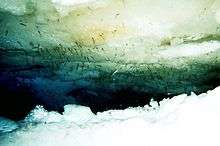Ice alga
Ice algae is any of the various types of algal communities encountered in annual and multi-year sea-ice. The ice algal communities play an important role in primary production and are therefore considered an important part of both Polar ecosystems.

Sea-ice algal communities can be found between ice crystals or attached to them, in the interstitial water or brine channels between ice crystals, or simply associated with the undersurface of the ice.
Although phytoplankton production is greater than that of ice algae on an annual basis in most offshore regions of the Southern Ocean, blooms of sea-ice algae differ considerably from the phytoplankton in terms of timing and distribution. Thus sea-ice algae provide food resources for higher trophic level organizations that nisms in seasons and regions where water column biological production is low or negligible.
A different kind of ice algae live on glacier surfaces, a permanently cold freshwater ecosystem. Known members of this group include Mesotaenium berggrenii and Ancylonema nordensskiöldii.
Further reading
- Arrigo, K. R., Brown, Z. W, & Mills, M. M. (2014) Sea ice algal biomass and physiology in the Amundsen Sea, Antarctica. Elementa. Retrieved 24 November 2014. doi:10.12952/journal.elementa.000028